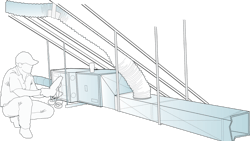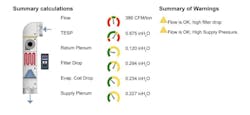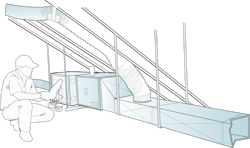Prescribe an Air Upgrade Scope of Work
Last month, we examined how to determine customer interest in an Air Upgrade™. Knowing how to discuss test results with a customer helps gauge their interest in these pre-packaged repairs. However, there’s a big difference in discussing test results and converting them into solutions. They are two totally different skills. Many Air Upgrade projects don’t deliver the expected results because the tech or salesperson doesn’t know how to diagnose the test-in readings and then convert them to relevant repairs.
FIND LAST MONTH'S ARTICLE HERE
This month, we’ll look at one of the biggest challenges to completing an Air Upgrade – prescribing an accurate scope of work. We’ll also consider another product that may be more suitable for your customers, depending on the goals they have for their HVAC system and comfort needs. Let’s look at how you can confidently prescribe an Air Upgrade scope of work.
Diagnose Your Test-In Readings
At this point in the Air Upgrade process, you should have static pressure and fan airflow measurements. You’ll need to compare each measurement to a target or baseline, so it has meaning. This is where manufacturer equipment specifications and design data come in handy. They are the most reliable sources of information. However, you might find yourself in a pinch and need to use some rules of thumb. If you find yourself in this situation, be upfront with the customer, document your assumptions, and find reliable data to replace them.
The NCI AirMaxx™ workflows used in the measureQuick and TrueFlow apps help simplify the diagnostic process and provide many of the targets you need. In the report snippet above, we have a downflow gas furnace with a variable speed motor. The furnace is moving the proper amount of cooling airflow but paying a price to do it. That price may be a premature failure. Further evaluation of the readings shows the air filter and supply duct system have the largest variation from the target values. These are the areas an Air Upgrade should focus on. It’s a good idea to take photos of these trouble areas for reference later.
Once you’re comfortable with your diagnosis, ask the customer to diagnose the report readings with you. Make the system diagnosis their idea. Be their guide so they understand what the readings mean and can identify measurements with the largest variations.
Once you diagnose the readings together, it’s time to consider solutions for the areas that need attention. Sometimes, repairs and/or adjustments are simple. Other times, they will be more complex. You won’t know for sure which is the best choice until you discuss options with the customer.
Discuss Options
My friend, David Holt, has my favorite advice for discussing options with a customer. He says, “Put yourself in the customer’s shoes and look through their eyes.” This simple statement changes the entire context of how you prescribe Air Upgrades.
Your approach shifts as you focus on the customer’s best interests and desires while looking for what is right. Remember, sometimes, customers freak out about having a major expense. Don’t make them feel like you’re piling on more. Instead, help them see how you can protect their new investment or repair.
You can now show photos of problem areas in the system that correspond with the measurements farthest from target values. In the report snippet above, the explanations give further details about the air filter and supply duct system, so your photos and options should focus on those areas.
Add commentary to the photos as you connect report data and explanations, so your customer has the knowledge they need to make a wise choice. Their decision will determine your next steps.
Anticipate the Fork in the Road
Sometimes the customer wants a higher level of comfort that requires work beyond the pre-packaged repairs in an Air Upgrade. This is when it’s time to offer a different option called Duct Optimization™.
Duct Optimization is a fully customized solution of surgical duct repairs. To discover it, you offer the customer airflow diagnostic testing and design work for an additional fee. The customer invests in your time and expertise to address advanced problems. With their help, you both discover needed repairs based on field measurements while making the customer a detective in their home. It’s a fun way to engage your customers and focus on the skills that separate you from the competition.
The goal of Duct Optimization is to deliver heating and cooling within ± 10% of design specifications to individual rooms. This is tougher than it sounds.
Like Air Upgrades, you can incorporate Duct Optimization during equipment replacement or upgrade. However, you’ll rarely complete this level of work during the timeframe of a typical replacement. Depending on the project, it can take more than one day to complete. If appropriate, you may choose to offer this profitable work to your customers during slower times to keep your installation crews busy.
Unfortunately, sometimes things won’t go your way and you won’t like the customer’s decision. Their answer may be to do nothing. Remember, sometimes “no” means “not now,” so don’t give up. There are other times the house will just beat you and the only options require major work a customer isn’t willing to invest in.
Communicate the Scope of Work
For this article series, we’re going to assume the customer is interested in an Air Upgrade and decides to move forward with the work. Your job now is to fulfill their expectations and communicate those expectations to everyone involved in the Air Upgrade project. There are two scopes of work – one for the customer and one for your team.
It’s easy to get excited about the sale and forget the basics such as getting the right materials ordered. Don’t forget to capture specific customer requests and let the installation team know what’s expected. The smallest detail in your eyes might be what’s most important to the customer. That’s another reason to remember the basics, which include details such as where to park, pets in the home, rooms to avoid, and times to be out of the home.
Most Air Upgrades fail during the hand-off from sales to installation. Pay special attention to this transition. It’s so important and overlooked that I’m dedicating the next article in this series to the topic.
David Richardson serves the HVAC industry as vice president of training for National Comfort Institute, Inc. (NCI). NCI specializes in training that focuses on improving, measuring, and verifying HVAC and Building Performance.
If you’re an HVAC contractor or technician interested in learning more about Air Upgrades, contact David at ncilink.com/ContactMe. NCI’s website www.nationalcomfortinstitute.com is full of free information to help you improve your professionalism and strengthen your company.



